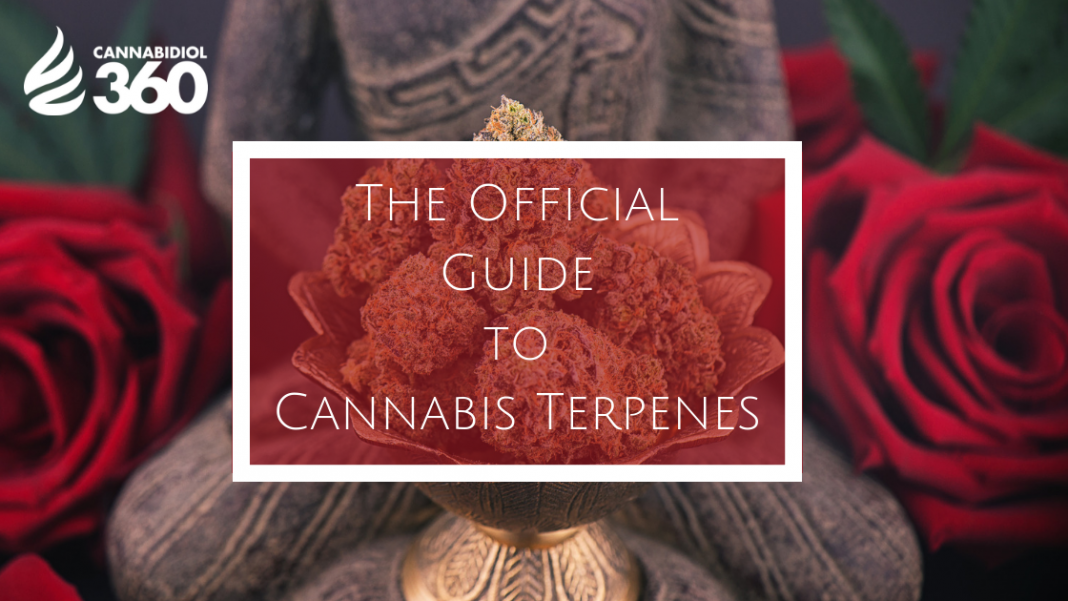
What Are Terpenes?
Terpenes are the main chemical compound found in plants that are responsible for their characteristic aroma. There are over 20,000 known varieties of terpenes that exist in the world.
The wide variance of terpenes is to thank for all the different smells every different kind of plant gives off. Their production is typically increased with exposure to light. These aroma producing compounds can also be described as an essential oil. They are extracted from the given plant by way of steam distillation or vaporization.
It is important to know the difference between terpenes and terpenoids, as they are sometimes used interchangeably, but they are two different things. Terpenes are hydrocarbons, which means the only two elements they contain are carbon and hydrogen.
Terpenoids, on the other hand, have been denatured through oxidation, which is the drying and curing of flowers, and/or chemically modified.
The key role that terpenes play in plants and flowers is protecting them from bacteria and fungus, insects, and other harmful environmental dangers. Depending on factors like weather, climate, age and maturation, fertilizers, soil type, and even the time of day, one plants terpenes will develop differently than the next. They typically either combine with or dissolve in lipids and fats.
Although there are multiple research studies discussing the positive health effects of terpenes and the synergistic effects of taking terpenes, both alone and with cannabis, the topic deserves more research.
The Most Common Cannabis Terpenes

When we think of great smelling plants, the cannabis plant provides some of the most alluring scents of any plant out there. These wonderful fragrances can be traced back to the their terpenes that are being synthesized in the secretory cells of cannabis inside of the glandular trichomes.
The highest concentration of terpenes are located in unfertilized female cannabis flowers before senescence, which is the process of deterioration with age. Terpenes in the cannabis plant are secreted from the same glands that produce THC, CBD, and other cannabinoids.
However, they are not cannabinoids. There are over 100 different kinds of terpenes for each strain. The most common terpenes found in the chemical makeup of the cannabis plant include:
– Alpha-Pinene:
Not too surprisingly, the Alpha-Pinene, which is a bicyclic monoterpenoid, provides for a fresh and woodsy piney, fir-like smell. Although it evolved to repel off any predators, it can offer certain medicinal health benefits, such as asthma relief, ulcers, anxiety, pain, inflammation, and possibly even cancer. It may also be able to help aid in alertness and memory retention.
Alpha-Pinene can also be found in other plants, such as pine needles, dill, parsley, rosemary, confider trees, orange peels, balsamic resin, and basil.
There are two kinds of Pinene found in nature, one is α-pinene and the other is β-pinene. α-pinene is the most common, although both forms are important components of pine resin and the two main components of wood turpentine. Alpha-pinene is one terpene that tends to have chemical reactions with other chemicals, resulting in other terpenes being created, like limonene.
– Myrcene:
Also known by the name Beta-myrcene, this terpene is also found in several cannabis strains, as it is the most common terpene found in the cannabis plant. Some strains can contain up to 60% of this essential oil.
It has a very earthy, musky, clove-like smell, which lends a feeling of relaxation mild sedation in consumers when concentrated in amounts above 0.5.
Myrcene has been shown to possibly treat insomnia, inflammation, and pain, as well as lowering the resistance across the blood to brain barrier, which allows for it and other beneficial chemicals to pass into the brain more readily.
It is also thought to work as an antioxidant analgesic, anti-inflammatory, antibiotic and antimutagenic, blocking the harmful effects of cytochrome, aflatoxin B and other pro-mutagenic carcinogens.
In addition, β-myrcene acts as an inhibitor of gastric and duodenal ulcers, meaning it may be helpful in preventing peptic ulcer disease. Its potential effects may be relaxing and slightly sedating if taken in large doses.
In particular, Myrcene allows for the effects of CBD to come on more quickly, as well as increasing the maximum saturation level of the CB1 receptor. For THC, this allows for a greater psychoactive effect.
Myrcene is also found in hops, eucalyptus, bay leaves, lemongrass, wild thyme, and countless other wild plants.
As a side note, many regular cannabis users claim that, since this essential oil is commonly found in citrus fruits, eating a ripe mango 45 minutes prior to consuming cannabis can produce a faster and more intense experience of psychoactivity.
– Limonene:

With an uplifting citrusy scent, this common cannabis Limone terpene is present in strains like Citrus Kush, Pineapple, Super Lemon Haze, and Super Silver Haze, as well as in other plants like rosemary, peppermint, juniper, pine needle oils, and the fruit rinds of oranges, lemons, and limes.
It is a monocyclic monoterpenoid that is one of two compounds created from pinene. It’s medicinal uses include treating pain, anxiety, depression, inflammation, suppressing the growth of fungi and bacteria, and even treating cancer. It is currently being studied for its effects on breast cancer treatment when taken orally.
Some have claimed that it can even be helpful for weight loss purposes. Limonene is quickly absorbed by the bloodstream after inhalation, so its effects occur at faster rates than the average terpenes. However, because of this fast absorption, it assists in helping other terpenes absorb quicker through the skin and other tissues.
A couple of the benefits it provides to consumers are an elevation in mood and stress relief, which is why it is known as the “feel-good terpene”. In nature, limonene acts as an insecticide to ward off insects predators from the plants it is found within. Due to its low toxicity level, it is used in many different foods, citrus cleaners, and perfumes.
– Beta-Caryophyllene:
This cannabis terpene is a sesquiterpene, that is also called simply caryophyllene. It emits a woody, peppery, and spicy clove smell, so naturally, it is found a bunch of edible plants and spices, such as black pepper, cloves, Thai basils, cinnamon leaves, and in very small quantities in lavender. It is also found in various herbs like oregano, basil, hops, rosemary.
It is known to help relieve anxiety, depression, pain, and ulcers. Due to its strong stress-relieving and medicinal properties, it is often found in topical salves and topical marijuana. Caryophyllene is the only known terpene that interacts with the endocannabinoid system (CB2).
This explains why β–caryophyllene is being studied for treating cancer. Other studies have found that caryophyllene to be a functional non-psychoactive CB2 receptor ligand in foods and as a macrocyclic anti-inflammatory cannabinoid.
Other phytocannabinoids used together, especially cannabidiol (CBD) and β-caryophyllene are great for chronic pain, thanks to their high safety profile and low adverse effects. A study done conducted by Horváth et al study shows that β-caryophyllene may also be helpful in preventing nephrotoxicity (a poisonous effect on the kidneys) caused by anti-cancer chemotherapy drugs such as cisplatin.
Black pepper, of which Beta- Caryophyllene oil is extracted from, has antioxidant, anti-inflammatory and antinociceptive properties, meaning caryophyllene can be useful in treating ailments such as arthritis and neuropathy pain.
– Linalool:

Linalool, a non-cyclic monoterpenoid, is commonly found in over 200 plants, one being cannabis plants and flowers like Lavender. It is known for its fresh floral scent.
People use it medicinally to treat insomnia (with people using it as a natural sleep aid all over the world for centuries), depression, anxiety, pain, neurodegenerative disease, boost the immune system, and to significantly decrease inflammation in the lung. Because it is able to counteract the effects of smoke in the lungs, it can help to reduce the harmful effects that come with smoking cannabis.
Also, linalool is often used to restore emotional and cognitive function, making it helpful for people who suffer from Alzheimer’s. When consumed, it also serves the user by enhancing their mood and inducing mild sedating effects.
It lessens the anxious emotions that some people can get from THC, which is why it is used to treat psychosis and anxiety.
The Environmental Protection Agency approves its use as a pesticide, flavor agent and scent, so it is used quite often in bath and body products, being found in the ingredient list as beta linalool, linalyl alcohol, linaloyl oxide, p-linalool, and alloocimenol.
The vapors it releases naturally have also been found to work great as an insecticide to fight off fruit flies, fleas and cockroaches. Because of it being such a common terpene, the average person will naturally consume about two grams of it each year, regardless of whether or not they use hemp.
-Humulene:
Aside from cannabis, Humulene, a sesquiterpene also known as α-humulene and α–caryophyllene, is present in spices like Vietnamese coriander, cloves, basil, and hops. It has a warming earthy and woody aroma.
As an ancient Chinese medicine, consumers who use it for medicinal purposes are often utilizing it for its anti-inflammatory, anti-tumor, anti-bacterial, and anorectic (appetite suppressant) properties.
It’s anti-inflammatory properties are often increased when it is blended with β–caryophyllene and used as a major remedy for inflammation.
Recreational users note its ability to suppress hunger, making it the perfect choice for cannabis lovers who are trying to avoid getting “the munchies”.
– Ocimene:
Ocimene is a hydrocarbon terpene that is responsible for protecting its plant against predators when in their natural environment.
It brings a lovely herbal, woody, and sweet scent to several plants and fruits, such as parsley, pepper, mint, basil, orchids, and kumquats. Ocimene is often used in perfumes for its beloved sweet and complex aroma.
However, people tend to use it medicinally because it is an antiseptic, antiviral, anti-fungal, antibacterial, and a decongestant.
– Terpinolene:
Smelling somewhat like a mix between Ocimene and Linalool, this terpene has a herbal, floral, piney smell to it. Also, like Ocimene, it is a hydrocarbon, and it can be found in apples, the tea tree, lilacs, nutmeg, conifers, and cumin.
Terpinolene is a favorite for its potential uplifting qualities, as well as for the fact that it has the potential to be an antibacterial, antioxidant, anti-cancer, and anti-fungal.
Synergistic Cannabis and Terpene Benefits

The FDA and other like agencies have generally agreed that the use of terpenes for medicinal purposes is safe. They work in the body by producing a positive reaction from neurotransmitters and receptors.
Some examples of how they do this include acting as serotonin uptake inhibitors, improving norepinephrine activity, increasing dopamine activity, and augmenting GABA, which is the “downer” neurotransmitter that counters glutamate (the upper neurotransmitter).
In other words, terpenes act as antidepressants. Many people have found that using cannabis in conjunction with terpenes can be very beneficial, as it creates a sort of ‘entourage effect’.
This entourage effect describes the process by which the different individual compounds in cannabis complement one another, and interact to produce a better or stronger effect for the user than they would on their own.
Since terpenes have been found in studies to be cannabinoids, it only makes sense that they would work well together.
For example, in studies, Dr. Ethan Russo has found that the non-cannabinoid molecules found in cannabis, such as terpenes, can act as inhibitors to the high that THC gives. This decrease in THC intoxication results in its therapeutic effect being simultaneously increased.
Dr. Russo refers to this counteracting effect as “phytocannabinoid-terpenoid synergy”. For this reason, combining terpenes and cannabinoids can provide for more effective cannabis-based medicinal extracts that treat pain, inflammation, bacterial and fungal infections, anxiety, depression, addiction, epilepsy, and even cancer.
There are various types of CBD products available on the market that contain many kinds of terpenes to choose from. These products are usually different flavors of vape juice and CBD oil with terpenes in it.












